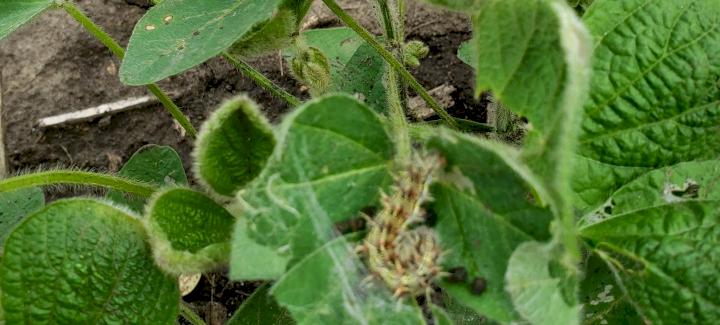
Thistle caterpillars are about as unwanted in growers’ fields as their name suggests. They were an issue for many growers last year, and we’re starting to hear reports of their presence in the Midwest again this year. These pests feed off soybean leaves until they transform into painted lady butterflies. However, before they transform, the caterpillars can cause defoliation in the upper canopy of soybean plants and further injury if left untreated.
Migration
Painted lady butterflies, which have orange and brownish black markings, migrate to the Midwest from the southern U.S. states each spring to lay their eggs on the top side of leaves. They prefer to lay on soybean, Canada thistle and sunflower leaves. Because the insects can’t overwinter in the Midwest, thistle caterpillars occasionally strike in large infestations when butterflies migrate to a specific area to lay their eggs.
Detection
The butterflies’ eggs are a pale green color and shaped like a barrel with vertical ridges. The eggs may blend into soybean leaves, and growers can more easily spot a network of webs the caterpillars weave along the borders of leaves. These webs provide a protected area under which the caterpillars feed.
In addition to spotting webs, soybean growers can identify the caterpillars by their spiny, thistle-like hairs that make the caterpillar appear prickly. The hairs seem to stick up in branches with several hairs clustered together. Each caterpillar is about one and one-fourth inches long, and has brownish black and yellow striping running horizontally across its body. The caterpillars feed on the top leaves of plants for about two to six weeks before developing a chrysalis.
Right now, growers may only be able to detect the larvae. In the coming weeks, the caterpillars should start to emerge.
Damage to Crops
If growers aren’t able to spot the eggs or caterpillars, they may see the damage to the top canopy of their soybean leaves. It’s important to scout soybean fields in early to mid-June to identify a potential infestation. To estimate defoliation, determine the damage done to top, middle and bottom leaves on a soybean plant, averaging the percentages. If defoliation occurs to 20 percent or more of soybean plants’ leaves, it may be time for an insecticide treatment.
However, some experts warn against overestimating defoliation. Because the caterpillars most often feast on the top layer of foliage, damage is easily visible. Don’t assume that the caterpillar is feeding on the middle and bottom layers of the plant without digging a little deeper. Additionally, these insects tend to gravitate toward the edges of fields, so growers may find it beneficial to scout in the middle of a field and then work their way out.
Mitigation
While it may be difficult to prevent thistle caterpillars altogether, soybean growers may have a better chance at staving off large infestations by keeping fields clear of thistles, specifically Canada thistle. Observations of infested fields in North Dakota indicate that thistle caterpillar populations are greater in areas where thistle is established.
If farmers identify the insects or damage to soybean crops near thistles at the edge of fields, its best to treat by spot spraying a herbicide on the thistle and following up with an insecticide on the healthy plants surrounding the damaged crop. This combination is suggested because using only the herbicide could push the caterpillars further into the field to feed on healthy plants.
If you have concerns about thistle caterpillars affecting your fields this summer or questions on how to manage the pest, contact your local Stine sales agronomist to discuss your options.
Related Articles
-

Stine® to offer Syngenta’s Victrato® soybean seed treatment in 2026
December 2025 in Agronomy
-

Use Stine’s XP® seed treatments to prevent early injury to your crops
December 2025 in Agronomy
-

Understanding Stine’s enhanced oil profile soybeans
December 2025 in Agronomy
-

Soil sampling sets the stage for spring
November 2025 in Agronomy



